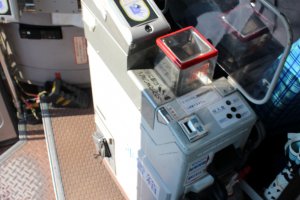The Christmas tree scent of pine sap hung intermittently in the air, mingling with the damp smell of autumn leaves. The rustling of the wind in the trees and the rushing of the Sanjo River provided a soothing soundscape and autumnal fire blazed on the opposite riverbank. An experience this good was possible because I got off the trains and took a bus deep into Japans’ mountainous wonders.
Bus Trouble
Taking the bus in Japan can be daunting. Even the local populace has trouble with it. Some buses require riders to pay when boarding, some have riders pay when getting off, some buses have a set fare and some buses have a fare that varies with distance traveled and some have both! The greatest trouble maker of all the bus related problems is the fare machine. Here’s to resolving all the confusion.
When to Pay
On the average city bus, the kind with a door at the front and the back, which door you use when boarding and getting off is the best indicator of when to pay and what system, set fare or fare set by distance traveled, is in place. If the boarding door is the front door then riders pay when getting on and the fare is a set fare which should be posted on the fare machine. Ask the bus driver if you’re not sure.
If the boarding door is the rear door it’s pay when you get off. Check for a ticket distribution box on either side of the door, it’s usually orange in color. Take a ticket and look at the number (or kanji characters) on it. There should be a display with numbers at the front of the bus. Each number represents a fare zone. The bus fare is calculated by the distance traveled. Check the fare display again when getting off the bus and pay the corresponding fare. Put both the ticket and the money into the fare box. If you board a bus by the rear door and there is no ticket check the fare display for a “0” or a “券なし” (no ticket) option. If there is one it means that “no ticket” is one of the fare zones. Watch that display and pay the displayed amount when getting off the bus.
The Bus Fare Machine
The greatest confusion-maker of any bus ride in Japan is the fare machine and its attached change machine. The fare box, on top of the machine, only accepts exact change. Put more than the fare’s amount in and you are out the difference. If you don’t have the exact fare amount use the change machine. It unfortunately does not work like a vending machine and deduct the fare from the amount riders put in, in only breaks ¥50, ¥100 and ¥500 coins and ¥1,000 notes. Get the change needed to pay the exact fare from the change machine.
Off the Beaten Track
Japan’s railway network may be the most extensive and comprehensive in the world but there are so many places that trains can’t or don’t go. Getting the bus to those places can get one away from the crowds and into the hidden gems that can’t be found in any guide book.






























